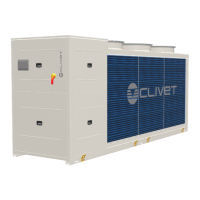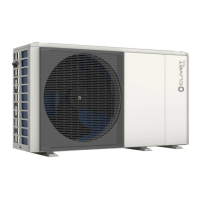
Do you have a question about the CLIVET WiSAN-YEE1 60.4 and is the answer not in the manual?
General safety precautions for unit operation.
Identification and handling of potential hazards.
Safety aspects during unit installation.
Procedures for unit malfunction.
Steps to take in case of unit breakdown.
Warning about fluorinated greenhouse gases.
Procedures for inspecting deliveries and reporting issues.
Guidelines for safe unit handling and required PPE.
General requirements and site selection criteria.
Ensuring unobstructed airflow for unit performance.
Requirements for water quality to prevent damage and ensure efficiency.
Critical steps before starting the unit pump.
General guidelines for making electrical connections.
Necessary specifications for the power supply network.
Terminal block details for customer connections.
Essential checks and precautions before unit start-up.
Checklist for ensuring the unit is safely powered off.
Checklist for ensuring the unit is ready for operation.
Critical checks for the refrigeration circuit.
Verification of the electrical circuit integrity.
Interpretation of icons and symbols on the unit display.
Accessing and interpreting unit operational data.
Codes and descriptions for various unit operational states.
Detailed description of Modbus registers for unit control.
Adjusting operating mode and temperature setpoints.
Codes and explanations for unit alarms.
Safety assessments for areas where refrigerants are present.
Standardized procedures for refrigerant handling.
Safety measures for personnel in the work environment.
Methods for detecting refrigerant leaks.
Ensuring appropriate fire safety equipment is available.
Eliminating potential ignition sources.
Importance of adequate ventilation during operations.
Safety checks for cooling systems containing refrigerants.
Safety inspections for electrical components.
Procedures for servicing sealed components.
Safe practices for dismantling equipment and recovering refrigerant.
Approved techniques for identifying refrigerant leaks.
Best practices for safe refrigerant recovery.
Safe procedures for refrigerant removal and system evacuation.
Guidelines for transporting and storing equipment with refrigerants.
Requirements and best practices for refrigerant charging.
Safety protocols to be followed during maintenance.
General guidelines for authorized maintenance.
A table detailing routine maintenance tasks and frequencies.
Procedures for safely disconnecting and preparing the unit for removal.
Hazards associated with electrical components and connections.
Hazards and safety measures related to refrigerants.











